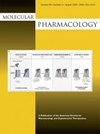G 蛋白偶联受体(GPCR)的非形态化:历史视角。
IF 3.2
3区 医学
Q2 PHARMACOLOGY & PHARMACY
引用次数: 0
摘要
G 蛋白偶联受体(GPCR)有 800 多个成员,是人类基因组中编码的最大的膜受体家族。自 20 世纪 70 年代末和 80 年代初发现 G 蛋白和 GPCR 以来,GPCR 研究的很大一部分都集中在配体/受体对的鉴定上,与此同时,还对其信号特性进行了研究。尽管取得了重大进展,但在约 400 个非臭味 GPCR 中,仍有约四分之一被认为是 "孤儿",因为它们的天然或内源配体尚未确定。我们应该考虑到,每个 GPCR 都曾是 "孤儿",而内源配体往往在尚未完全了解其靶受体分子特性的情况下就与生物效应相关联。在这一框架内,本综述从历史角度探讨了具有代表性的 GPCR(包括胃泌素受体、GABAB 受体、芹菜素受体、大麻素受体和 GPR15)的非孤儿化过程。综述探讨了非形态化过程中遇到的三种主要情况,并讨论了在阐明配体-受体相互作用时遇到的关键问题和采用的方法,为今后的研究工作提供了启示。本文章由计算机程序翻译,如有差异,请以英文原文为准。
Deorphanization of G Protein Coupled Receptors (GPCRs): a historical perspective.
Counting over 800 members, G Protein Coupled Receptors (GPCRs) form the largest family of membrane receptors encoded in the human genome. Since the discovery of G proteins and GPCRs in the late 1970s and early 1980s, a significant portion of the GPCR research has been focused on identifying ligand/receptor pairs in parallel to studies related to their signaling properties. Despite significant advancements, about a fourth of the ~400 non-odorant GPCRs are still considered orphan because their natural or endogenous ligands have yet to be identified. We should consider that every GPCR was once an orphan and that endogenous ligands have often been associated with biological effects without a complete understanding of the molecular identity of their target receptors. Within this framework, this review offers a historical perspective on deorphanization processes for representative GPCRs, including Ghrelin receptor, GABAB receptor, Apelin receptor, Cannabinoid receptors, and GPR15. It explores three main scenarios encountered in deorphanization efforts and discusses key questions and methodologies employed in elucidating ligand-receptor interactions, providing insights for future research endeavors.
求助全文
通过发布文献求助,成功后即可免费获取论文全文。
去求助
来源期刊

Molecular Pharmacology
医学-药学
CiteScore
7.20
自引率
2.80%
发文量
50
审稿时长
3-6 weeks
期刊介绍:
Molecular Pharmacology publishes findings derived from the application of innovative structural biology, biochemistry, biophysics, physiology, genetics, and molecular biology to basic pharmacological problems that provide mechanistic insights that are broadly important for the fields of pharmacology and toxicology. Relevant topics include:
Molecular Signaling / Mechanism of Drug Action
Chemical Biology / Drug Discovery
Structure of Drug-Receptor Complex
Systems Analysis of Drug Action
Drug Transport / Metabolism
 求助内容:
求助内容: 应助结果提醒方式:
应助结果提醒方式:


